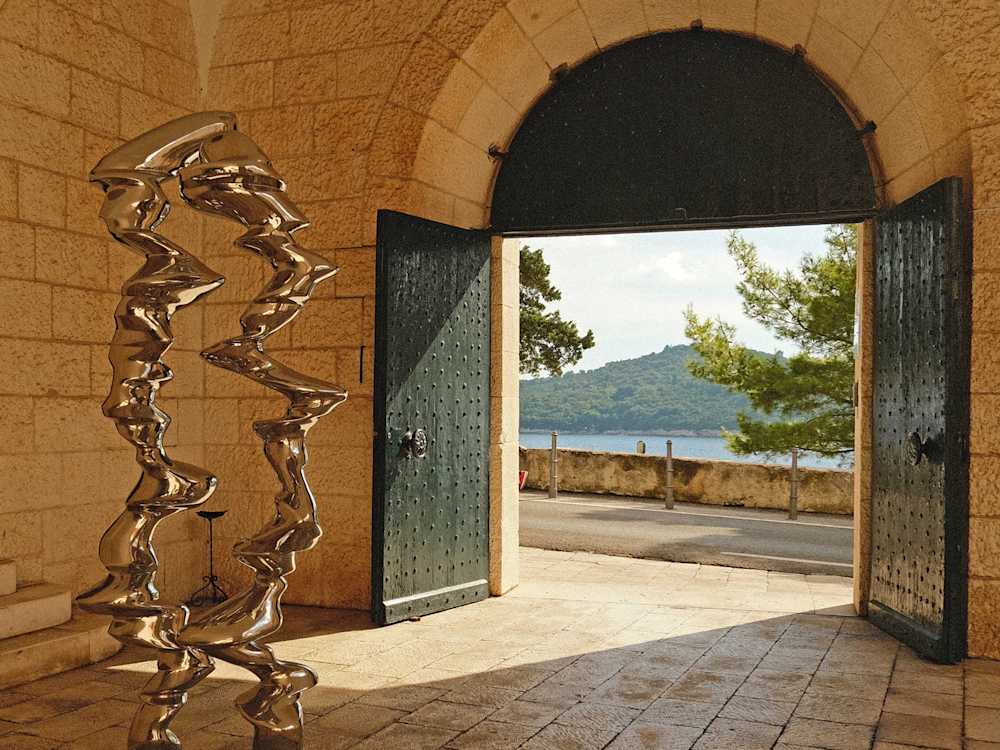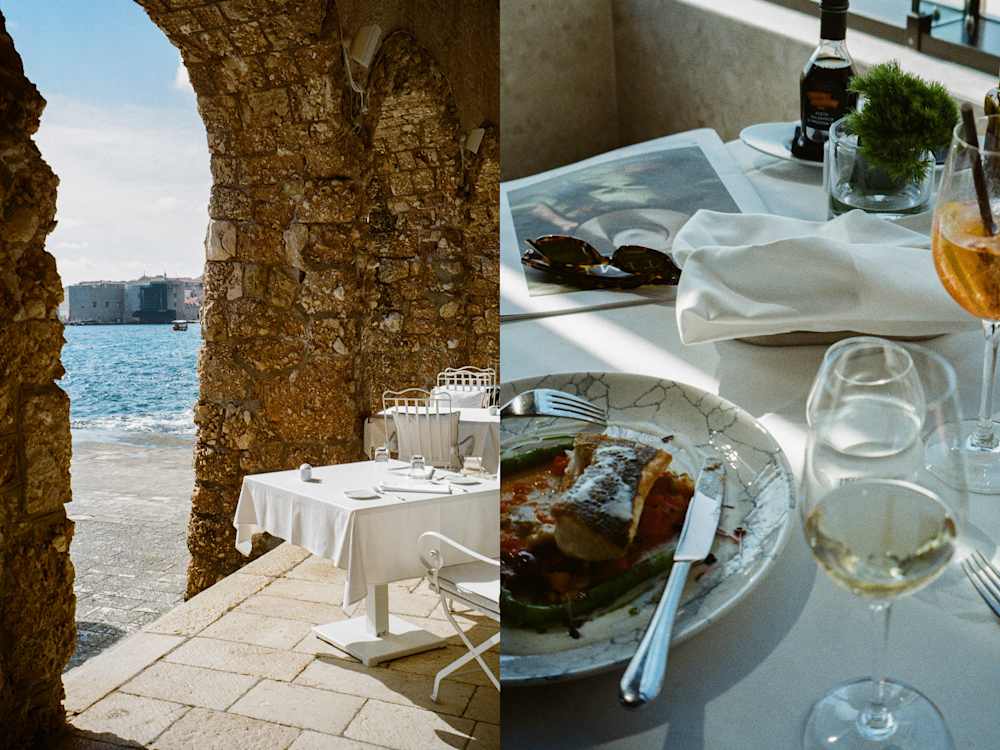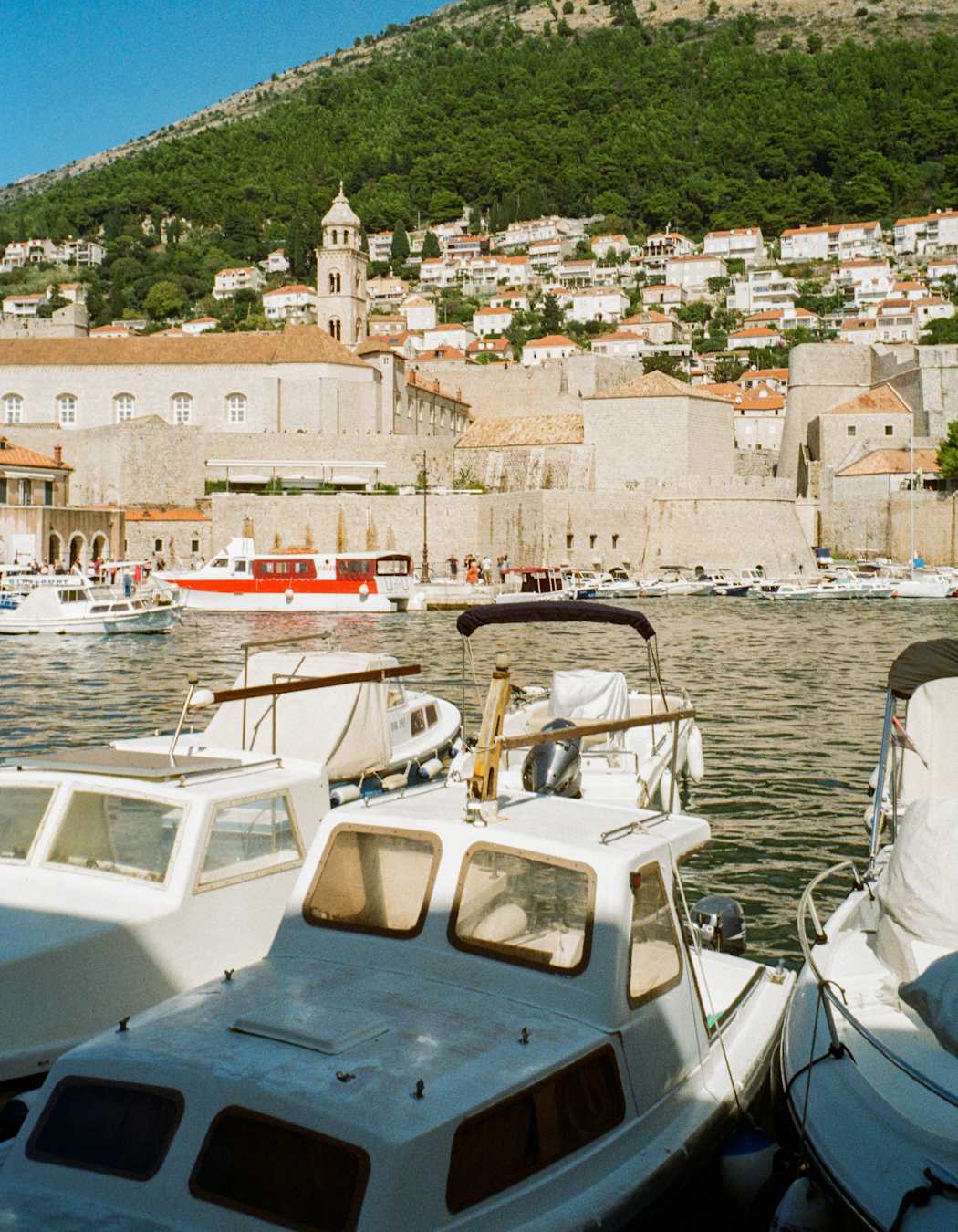The high drama of Game of Thrones may have caused weekend breaks in Dubrovnik to boom; but frankly, the Croatian city has no need for fictions. Its real-life story is far more fascinating, and every bit as full of romance, battles and dynastic upheaval as the show that borrowed its mediaeval Old Town setting. Compact, car-free and full to the brim with historic landmarks, it’s a perfect candidate for a quick getaway. Here’s how to spend 48 hours in Dubrovnik…
FRIDAY: EVENING

After touching down at Dubrovnik Ruđer Bošković Airport, call an Uber or hop in a cab at the taxi rank outside arrivals. Hold off heading into the city centre just yet; instead, motor straight to Palace Natali, a noble residence-turned-hotel in the foothills of Mount Srđ. Lending its heft as a dramatic backdrop to the walled Old Town, Srđ was once known for its thick forest of oak trees (dubrava), which gave Dubrovnik its name.
Palace Natali’s Adriatic Sea-spying suites are reason enough to lay your head here, but you’ll also be bedding down in one of the few surviving examples of Dubrovnik’s Renaissance-era summer palaces. It was built in the 16th century for the Natali family, a line of nobles who loom large in the city’s tempestuous history. One descendant, Đivo Natali, played a leading role in the 1813 uprising against Napoleon’s occupying army.
Once you’ve checked in, ask for a round of G&Ts to be brought out to the pergola at the foot of the garden, where you can put your feet up and watch the sun setting over Pile Bay. You’ll have ample time to explore the Old Town tomorrow, so tonight’s the night to eat in at Restaurant Natali. It’s helmed by Croatian chef Duje Smajo, who honed his craft in a string of Michelin-starred restaurants, including Noel in Zagreb and London’s Petersham Nurseries. His menu mingles Mediterranean and Asian flavours, with dishes like Dalmatian cuttlefish and fillet of turbot appearing alongside buns, gunkan bites and zingy fermentations.
SATURDAY: MORNING
Dubrovnik’s Unesco-protected Old Town beckons. You’ll rack up a respectable step count this morning, so don’t be coy at breakfast (head to Dubravka 1836, by Pile Gate, for fluffy omelettes and prime Adriatic views). The walk from Palace Natali is downhill all the way, following a network of staircases that descend to the city walls. These hefty ramparts were built over the course of 500 years, with work beginning in the 13th century, when Ragusa — as Dubrovnik was then called — was still under Venetian rule.
Walking the walls is the best way to see a whole swathe of the Old Town at once, along with its forts, watchtowers and bastions; Game of Thrones fans will recognise many of the ramparts from scenes depicting King’s Landing. Go for the Dubrovnik Pass (€40 a head), which grants access to the walls and a string of other historic sites, including the Rector’s Palace and Dubrovnik’s Museum of Modern Art.
Back at street level, stop for coffee at Café Festival, a long-running watering-hole on the Stradun, the Old Town’s main thoroughfare. The street is bookended by several Old Town landmarks: at the eastern side, there’s the 13th-century Franciscan Church and Onofrio’s Fountain, a cupolaed relic of the city’s early medieval waterworks. At the west end is the 16th-century Sponza Palace and Dubrovnik’s Bell Tower, sounded by two bronze automatons christened Maro and Baro.
Continue along Pred Dvorom to the Rector’s Palace, which doubles as the Cultural History Museum. Dubrovnik’s complex past is laid bare here, but the building itself is equally fascinating — if for rather unfortunate reasons. Its gunpowder store exploded twice, and it was further damaged in two earthquakes, resulting in a succession of rebuilds that led to a charming mishmash of Gothic, Renaissance and Baroque styles.
Time for lunch. You’ll get excellent seafood at Restaurant Proto Fish, on the intersection of Široka and Vara. This stalwart has been in business since 1886, turning out Adriatic catches-of-the-day, giant red prawns, crab, langoustines and oysters. Pair with a bottle of Dubrovacka Malvasija, a much-loved local white.
SATURDAY: AFTERNOON

Ready to delve into the Old Town’s warren of interior streets? Don’t be too methodical about it: wandering is more rewarding, as you’ll stumble upon hidden courtyards and statues of Saint Blaise, Dubrovnik’s patron saint. If you get peckish while on your circuits, keep an eye out for Alamaka, on Ulica Dropčeva. This Croatian tapas joint dishes up Dalmatian sausages, smoked tuna, stuffed peppers and Balkan-style kebabs. The richly favoured fare makes a fine match for Dingač: a full-bodied Croatian red from the Pelješac peninsula.
Once you’ve had your fill, start walking towards Ploče Gate at the east of the Old Town. Call in for creamy gelato at Peppino’s (on Ulica Svetog Dominika), right next door to Maria Store. This glamorous boutique carries womenswear from Saint Laurent, Loewe, Bottega Veneta, The Row and other on-the-pulse labels. Best finish that dripping ice cream before you cross the threshold…
Next, exit the Old Town through Ploče Gate and head straight along Ulica Frana Supila until you hit the Museum of Modern Art Dubrovnik. The gallery was built in 1939, originally as a home for Bozo Banac, a Yugoslavian ship owner who was, in his day, one of Dubrovnik’s wealthiest citizens. Since 1945, it’s housed a considerable collection of sculptures, paintings, prints and photographs by artists connected to the city.
That’s the afternoon wrapped. You can either head down to the bar on Banje Beach for sundowners or hop in an Uber and zip back to the hotel, where you can freshen up before dinner.
SATURDAY: EVENING
Kick off the evening at M’Arden, a wine bar in a courtyard garden off Ulica od Domina. Dubrovnik-born sommelier Ana Bitanga takes an open-minded approach to tipples, stocking plenty of natural and biodynamic varieties (at varying levels of funkiness) alongside the classics. Lean on the knowledgeable staff, if need be.
For dinner, you’ve two excellent options nearby. Atmospheric Nautika, on the Pile city walls, has a terrace overlooking the sea and the fortresses of Lovrijenac and Bokar. The menu draws inspiration from across the Mediterranean and a Saturday night table here is a coveted thing, so book way ahead.
Local, on Ulica Koločepska, has built its reputation on traditional peka (a Croatian one-pot dish that’s slow-cooked under a bell-shaped lid). Every peka is made from scratch, so you’ll need to call three hours in advance if you plan to order one. Round off the night with a round of rakija, Croatia’s national spirit: a potent fruit brandy usually made from plums.
SUNDAY: MORNING

Yes, that rakija can bite. If you feel like a shrivelled prune this morning, you’ll be happy to hear that day two is a more laidback affair.
A hearty — and healthful — brunch can be had at Soul Kitchen, a plant-based restaurant on Ulica od Domina. Stay sweet with a smoothie and fluffy French toast or try their poached eggs, served atop a flatbread that’s slathered in guacamole and spicy sauce.
Next, head back to Banje Beach, Dubrovnik’s main swimming spot, for a leisurely dip. It’s pebbly, so bring water shoes if you have them. If you’re willing to venture further, there’s also Plaža Sveti Jakov, a cliff-backed cove a little further along the coast. You can hire sunloungers for €25 a pop and get drinks and snacks at the beach bar.
For lunch, you’ve two strong options within walking distance. Hotel Villa Dubrovnik lays claim to a prime stretch of the rocky coastline, facing the Adriatic and Lokrum Island. Go for Giardino, the hotel’s waterside bistro, where you’re shaded by fragrant pines. Slightly closer to town is Hotel Excelsior Dubrovnik. It’s split between a historic villa that dates from 1913, and a modern wing with oversized windows, so you can soak up those cerulean blues. It’s in the latter that you’ll find restaurant Sensus, where the tables are angled to get the best of the cityscape. The octopus salad is a Croatian classic, as is the pan-fried seabass.
SUNDAY: AFTERNOON
If you want to hike, catch the 15-minute ferry (€27) to Lokrum Island, a nature reserve visible from Dubrovnik’s shores. There’s 180 acres of woodland to wander through, plus a Benedictine monastery, fortress and a botanical garden. It has some intriguing lore, too, including a brush with Richard the Lionheart. As legend has it, the monarch was almost shipwrecked nearby but found safe harbour on this isle.
Alternatively, ride Dubrovnik’s cable car to the peak of Mount Srđ; on a clear day, you can see over 30 miles from the summit. There’s a restaurant up there, too: Panorama, owned by the same group as Nautika. Order a round of spritzes and soak in the view. Over to your right, you’ll see Gruž Dubrovnik’s lively port area, with a down-to-earth vibe that feels more authentically local.
Here you’ll find the Red History Museum, reflecting on life under Yugoslavia’s Communist regime. It’s housed in the former — and fittingly utilitarian — TUP factory, a producer of graphite products. The exhibits exemplify the louder designs of the era, from cars in Soviet red to sofas in tangerine and brown.
Head up the road to close out the afternoon at the Dubrovnik Beer Company, a craft brewery producing a line of new-wave drinks. You can take a tour (which includes a tasting) or head straight to the tap room, where you can pair your pours with loaded fries, spicy wings and pulled-pork sandwiches.
SUNDAY: EVENING
Go big for dinner: Restaurant 360, atop the bastion next to Ploče Gate, is worthy of a last supper here. Lauded Croatian chef Marijo Curić has been awarded a Michelin star and several Gault & Millau ‘toques’ for his approach to the national cuisine, cheffed up with French precision. There are two tasting menus: Republika, a contemporary take on heritage dishes; and Antologia, where Curić lines up a series of his signatures.
Up on Mount Srđ, Konoba Dubrava is a different beast entirely. This rustic outpost, with its stone walls and timber ceiling, serves the kind of hearty fare a Croatian grandmother might make you. That means beef soup, bacon-wrapped pork loin, veal chops, ‘Dubrava’ steaks and a sort of cream-cheese-slathered doughnut that you can use to soak up all the juices. Knock back a few homemade grappas at the end of the meal and you’ll be dancing along to the folk music in no time.
NEED TO KNOW

Transport Dubrovnik’s Old Town is entirely car-free, and its compact size means its walkable. The only time you’re likely to need four wheels is if you want to hasten your trips to and from the hotel, or for getting to Gruž, the Lapad peninsula or more distant beaches. Aside from local taxis and Ubers, there’s a public bus service that runs between all the key districts.
When to go Spring and early autumn are the optimum times for exploring Dubrovnik, when the weather is clement and the crowds fewer. It’s a small place, so you do feel the uptick in footfall during high season. That said, the Dubrovnik Summer Festival (10 July to 25 August) is a spectacle, with classical music, theatre, art and exhibitions taking place.
What to buy Bring home a bottle or two of Dingač, a full-bodied crowd-pleaser of a wine. It’s considered one of Croatia’s more upmarket tipples, but it’s readily available in stores. Swing by Enoteca in the Old Town for advice on the best vintages.
Good to know When it comes to dinner, Dubrovnik is a book-ahead kind of place, especially in high season. You’re likely to be disappointed if you rock up to the city’s top restaurants without any warning.
See our full collection of hotels in Dubrovnik



